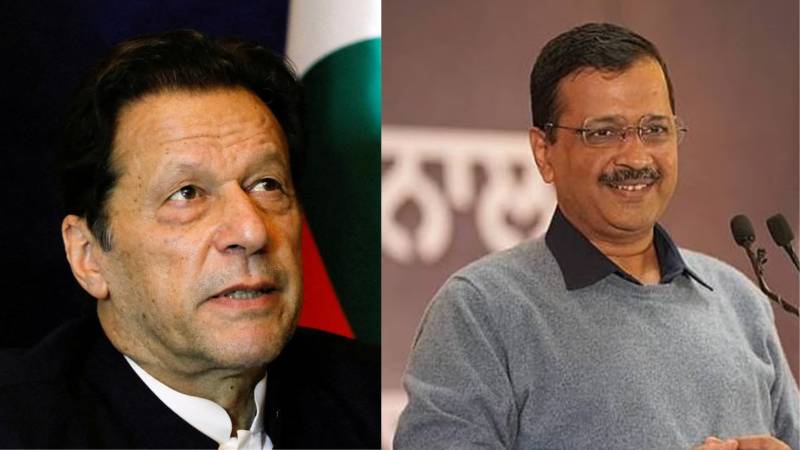
A decade ago, both Pakistan and India saw the rise of political mavericks—Imran Khan and Arvind Kejriwal—who promised to cleanse the system, end corruption, and bring governance back to the people.
Both men rode the wave of public frustration, presenting themselves as crusaders against entrenched elites. But today, while one remains a political force despite being ousted, the other, despite completing full terms, finds himself floundering, abandoned by the very people who once saw him as their champion.
Kejriwal’s meteoric rise in Delhi was a masterclass in branding. He styled himself as a crusader against corruption, draped himself in the credibility of the anti-corruption movement, and promised a utopia of ‘Swaraj’—only to deliver a bloated bureaucracy, blame games, and a taxpayer-funded personal luxury overhaul. Meanwhile, Khan, backed by Pakistan’s powerful establishment, sold the dream of ‘Naya Pakistan,’ challenging the dynastic rule of the Sharifs and Bhuttos. Yet, after falling out with his patrons, he was removed from power but paradoxically remains politically vibrant, with his popularity surging post-ouster.
Both men built their political careers on the promise of clean, alternative politics. Both engaged in dramatic populist rhetoric, portraying themselves as victims of the establishment. Yet, Kejriwal, despite having had the advantage of completing two terms in power, has seen his political capital erode. His party, AAP, once seen as a disruptor, now struggles for relevance. Khan, on the other hand, despite being in jail, continues to command massive public support in Pakistan, where his narrative of being wrongfully removed has only strengthened his appeal.
Kejriwal’s political journey mirrors Khan’s almost uncannily. Both men projected themselves as messianic reformers, both harnessed anti-corruption sentiments to topple established parties, and both ultimately succumbed to the very vices they once decried. Khan’s ‘Naya Pakistan’ promised prosperity, only to deliver chaos, vendettas, and a jail term. Kejriwal’s ‘alternative politics’ has ended in electoral wipeouts and allegations of financial mismanagement.
While Khan’s victim card continues to work wonders, keeping him politically alive despite his legal troubles, Kejriwal’s version has lost all resonance. His perpetual battle with Delhi’s Lieutenant Governor and the central government has begun to bore voters. “He was no longer the man we voted for in 2012,” admits Karandeep Ahuja, a businessman who once backed AAP but now prefers a government that ‘works with’ rather than ‘whines against’ the Centre.
One man remained a symbol of popularity, while ousted from power without completing a term; the other, allowed to rule, finds himself slipping into irrelevance
Kejriwal’s fall isn’t just about voter fatigue; it’s about strategic miscalculations. His attempts at expanding AAP beyond Delhi largely failed, barring Punjab. His attempts to woo Hindu voters through a soft Hindutva plank alienated Muslims. His silence during the 2022 Delhi riots didn’t go unnoticed. In the political marketplace, if you want Hindutva, you go for the real thing—the BJP. Kejriwal’s imitation was neither here nor there.
His attitude towards Jammu and Kashmir was most humiliating.
In August 2019, his party supported Prime Minister Narendra Modi's government in the abrogation of Article 370, the bifurcation of the state into two Union Territories, and its integration into the Indian Union. The irony is that while Arvind Kejriwal and his party lamented the lack of empowerment for the Delhi Assembly and his government, they were complicit in stripping Jammu and Kashmir of its autonomy and dividing it. This double standard further exposed their hypocrisy.
A Party in Crisis, A Dream in Ruins
In Pakistan, Khan’s ouster turned him into an underdog, fueling his support base rather than weakening it. Despite repeated attempts to sideline him, he remains at the centre of Pakistan’s political discourse. His incarceration has become a rallying cry for his supporters, reinforcing his image as the only true alternative to the country’s military-backed rulers.
But in India, where Kejriwal’s party completed 10 years in power was exposed. The recent Delhi election results confirmed what had been evident for years—AAP is no longer a political disruptor. The party is now at a crossroads, grappling with dwindling funds, a shrinking voter base, and a credibility crisis. The faces that once gave AAP its moral sheen—Yogendra Yadav, Prashant Bhushan, and Admiral L. Ramdas—have long walked away.
AAP’s early victories were fueled by crowdfunding and middle-class idealism. That model is now dead. With the BJP’s dominance returning to Delhi after 27 years, AAP’s financial and political independence is under existential threat. The coffers are drying up, and the sympathy is gone. Kejriwal’s signature protest politics, once a breath of fresh air, now reeks of stale opportunism.
The lesson from the Kejriwal saga is the same as the one from Imran Khan’s: populism is a brilliant way to win elections but a terrible way to govern. Both men built their movements on anger—against corruption, against dynasties, against the system. But anger alone doesn’t build roads, create jobs, or run a government. Governance requires pragmatism, not perpetual rebellion.
For Khan, paradoxically, being removed from power has kept him politically alive. His victim narrative resonates, and his party, despite all odds, remains formidable. For Kejriwal, his inability to navigate governance beyond populist slogans has led to a rapid decline. The man who once promised a political revolution has instead delivered a textbook case of political entropy.
For Pakistanis watching from across the border, the contrast couldn’t be clearer—one man remained a symbol of popularity, while ousted from power without completing a term; the other, allowed to rule, finds himself slipping into irrelevance. In the end, it seems, it’s not always about power—but how one loses it.

